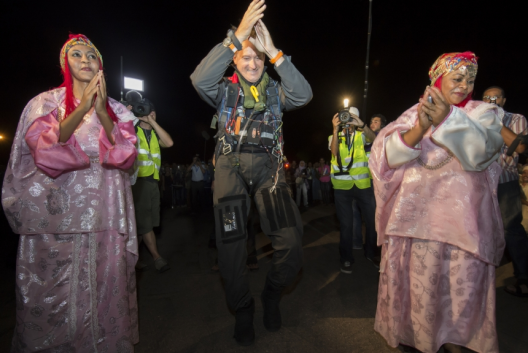But that’s a good thing, because it was on a nice runway with landing lights to help guide it down. On June 22, at 25 minutes after midnight, local time, André Borschberg touched down at Quarzazate, the site of Morocco’s huge new solar generating plant. Its second attempt at reaching this destination, Solar Impulse was flown through mid-day turbulence and shifting winds, but did not turn back as it had on the first attempt the week before.
The project’s press release provides an outline of the flight. “The Solar Impulse airplane took-off this morning at 07:05 (UTC+1) from Rabat-Salé. After flying in the direction of Casablanca, the HB-SIA made its way inland towards Marrakesh, avoiding the Atlas Mountains, and flying in the direction of the desert.” After flying 17 hours and 20 minutes, covering 683 kilometers (423 miles) Borschberg brought the airplane in for a perfect landing.
The project reports, “‘It was a beautiful flight with some amazing contrasts between the coast and interior landscapes, but the highlight was the view of the Atlas Mountains: breathtaking!’ said André Borschberg to the cheering of the Solar Impulse team, the Governor of Ouarzazate, Mayor of Marrakesh and local journalists. ‘It still remains one of the most difficult flights we’ve done and it wasn’t easy to find the adequate altitude to avoid turbulence, to charge the batteries and to avoid being too cold. But Ouarzazate was our final destination and we made it! It is a great satisfaction to finally be here for our project and our host’ said joyfully André Borschberg as he exited the aircraft.”
A solar-powered airplane flying to Morocco’s Quarzazate region, home to the Moroccan Agency for Solar Energy (MASEN), sends a powerful message as to the future of clean energy in the desert heat. This intense sunlight and heat will help power a 160 megawatt thermo-solar power plant, first of several such units that will eventually produce 500 MW. Morocco is counting on this and other forms of renewable energy to provide 42 percent of its energy needs in less than 10 years.
The contrast of this dragonfly-like, delicate craft with the power being harnessed in the shadow of the Atlas Mountains could not be more dramatic, nor could the courage of the pilots who brought the airplane from its Swiss home to a far harsher environment.

